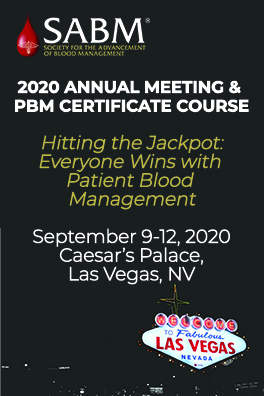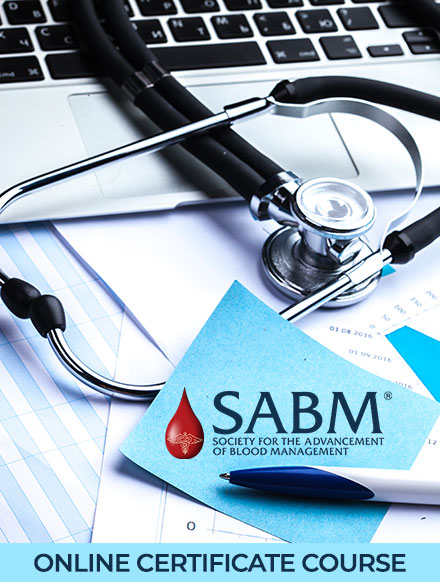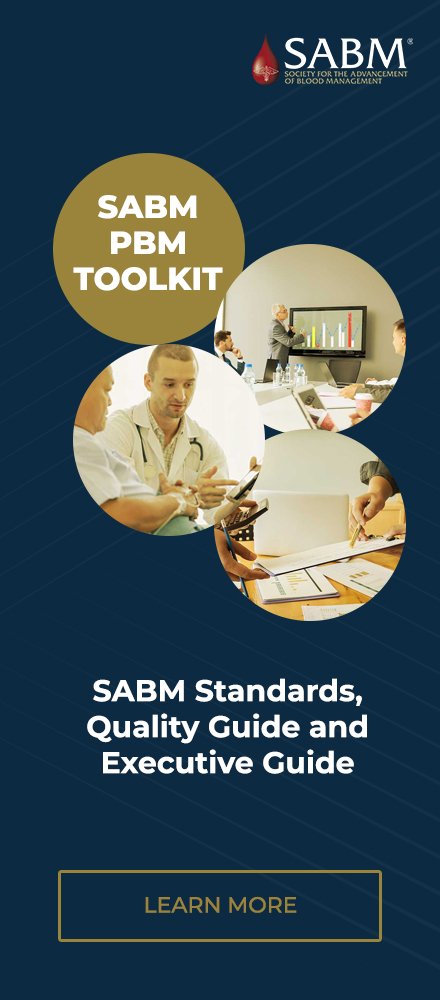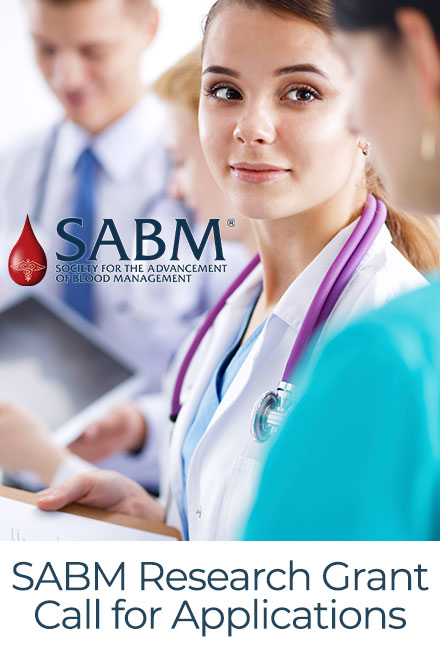MAY 2020
ISSUE

Please consider making a donation to your Society. Your donations will help us to improve the lives of people throughout the world through Patient Blood Management.
SABM 2020 Newsletter Publication
Editor: Kevin T. Wright
Associate Editor: Majed Refaai, MD
Contributors for This Issue
Christine Cahill, RN, MS
Ann Marie Gordon, PA-C, MLS (ASCP)
Beverly Khaek-On, BSN, RN
Mary Ann O'Brien, RN, MSN, CCRN, CNE
Sherri Ozawa, RN
Seth Perelman, MD, FASA
Majed Refaai, MD
Cassandra Upchurch, RN
Sarah Walbolt, BSN, RN
Kevin T. Wright
Marketing
Tim Bower, CAE
SABM Officers and
Directors
© 2020 Society for the Advancement of Blood Management
350 Engle Street Englewood, NJ 07631 USA Phone: (928) 551-6400 Fax: (877) 944-2272 EMAIL: [email protected] |
Breaking Clinical News
COVID-19, any light at the end of the tunnel?
The outbreak of acute respiratory disease caused by a novel coronavirus (Severe Acute Respiratory Syndrome-SARS-CoV-2; AKA, COVID-19), which first emerged in Wuhan, Hubei Province, China, about six months ago has rapidly grown into a serious global pandemic. Despite the extraordinary efforts to contain the spreading of this virus, significant numbers of new cases are confirmed almost every day throughout the world. Initially, the outbreak reportedly may have been linked to a seafood and wildlife market. However, person-to-person transmission has been confirmed via respiratory droplet contact (≤ 6 feet), skin contacts and even transmission through air while speaking are now major concerns.
As per CDC, symptoms of COVID-19 may appear in as few as 2 days or as long as 14 days after exposure (longest reported, 24 days). Common initial symptoms of COVID-19 infection include fever, cough, and shortness of breath, which are typically seen in any upper respiratory viral infections. Recently, the CDC has also added more symptoms as possible signs of COVID-19 infection, including chills, repeated shaking with chills, muscle pain, headache, sore throat and sensory changes such as new loss of smell or taste. Additionally, some symptoms have been observed clinically include nausea, vomiting, diarrhea, rash, delirium, and dizziness. In up to 60% of cases, however, infected individuals may manifest mild to no symptoms posing huge challenges in containing this pandemic crisis. On the other hand, mild to severe lower respiratory tract disease can be seen in advanced cases, which may progress to critical status as a result of cytokine storm requiring intubation and mechanical ventilation. Acute respiratory failure or a hypercoagulable state with widespread thromboembolic disease are also very common in these critical cases[1,2] .
According to the World Health Organization (WHO), as of today, May 11, 2020, this pandemic has spread to more than 193 countries with almost five million cases confirmed to be positive for COVID-19 and a death toll reaching an alarming figure of approximately 325,000 worldwide. These numbers are continuing to rise at a dramatic rate on a daily basis. In the US, initial cases were linked to overseas travel or a known exposure source; however, cases without known exposure or travel risk factors have been rapidly spreading. Today, after about 4 months of the first diagnosed case in the US, over 1,750,000 cases have been confirmed positive for COVID-19 with more than 92,000 related deaths.
Despite the fact that Wuhan, China was the source of this pandemic, the confirmed cases have not changed dramatically since mid-February. Up to date, about 83,000 cases have been confirmed positive for COVID-19 with a death toll of less than 5,000. This was a result of some earlier preventive and aggressive measures, such as the entire lockdown of affected cities and non-essential businesses, enforced social distancing, universal masking, and the changing in COVID-19 diagnosing criteria. Due to the initial delay in COVID-19 testing, and in order to reduce spreading, the China National Health Commission changed the diagnosis requirement criteria from a positive PCR testing to clinical symptoms and chest CT scan findings. This change in confirmatory diagnostics increased the number of confirmed cases markedly but it helped minimizing spreading significantly.
One of the earlier Chinese study about COVID-19 reported that in addition to the usual viral route of respiratory droplets, the virus could be transmitted by saliva, urine and stool. In this study, Guan et. al.[3] extracted data of 1,099 patients with laboratory-confirmed COVID-19 acute respiratory distress syndrome (ARDS) from 552 Chinese hospitals in 31 provinces through end of January 2020. The median age of these patients was 47 years and 58% were males. While only 1.2% of patients had a direct contact with wildlife, almost one-third (31%) had been to Wuhan city and the majority (72%) had contacted with people from Wuhan city. The most common symptoms were fever (88%) and cough (68%), whereas diarrhea was uncommon. Most importantly, the median incubation period was 3 days (ranged from 0 to 24 days). At time of admission, ground-glass opacity was the typical (50%) radiological finding on chest-computed tomography (CT scan). Interestingly, significant number of severe cases were diagnosed by clinical symptoms and reverse-transcriptase polymerase-chain-reaction (23.87% vs. 5.20%, p<0.001) with normal radiological findings. Lymphopenia was also observed in 82% of patients. Multivariate analysis, in competing-risk model, revealed that severe pneumonia was an independent factor associated with either ICU admission, mechanical ventilation, or death (hazards ratio, 9.80; 95% confidence interval, 4.06 to 23.67).
Diagnosis:
To date, seven recognized types of corona virus strains have been identified which can infect humans, include alpha coronavirus (229E and NL63) and beta coronavirus (OC43 and HKU1). The rare but more severe types are called MERS-CoV, which leads to Middle East Respiratory Syndrome (MERS), and SARS-CoV, responsible for SARS[4] .
Laboratory testing of COVID-19 infection is based on detection of unique sequences of viral RNA by real-time reverse-transcriptase polymerase chain reaction (RT-PCR) and sequencing. Detection is better in nasopharynx samples compared to throat samples or lower respiratory tract samples than upper tracts. Detection of SARS-CoV-2 RNA in blood may be a marker of severe illness. Currently several RT-PCR assays developed specifically for the COVID-19 include tests targeting upstream of the E protein gene (upE), the open reading frame 1b (ORF 1b) gene and the open reading frame 1a (ORF 1a) gene[5,6] . While the upE target assay is highly sensitive as well as the ORF 1a assay, the ORF 1b assay is considered less sensitive but more specific. Other target sites of the COVID-19 genome have been identified as well for sequencing to aid confirmation, such as the RNA-dependent RNA polymerase (RdRp) and nucleocapsid (N) protein genes[5, 6] . A new RT-PCR test that is designed for use with the Applied Biosystems 7500 Fast DX Real-Time PCR Instrument, commonly used to test for seasonal influenza, is now available in select US and International laboratories.
Other laboratory findings in COVID-19 infection include lymphopenia (in 83% of hospitalized cases), neutrophilia, and elevated levels of serum alanine aminotransferase, aspartate aminotransferase, lactate dehydrogenase, CRP, ferritin, and D-dimer. Significant high concentrations of CRP, ferritin, and D-dimer are usually associated with greater illness severity. Strong association have been recognized between high D-dimer and lymphopenia with mortality.
Bilateral air-space consolidation is typically seen on CXR; however, findings may be unremarkable early in the disease. Chest CT images usually demonstrate bilateral, peripheral ground glass opacities, which is non-specific to COVID-19 infection.
Management
Unlike influenza, up-to-date there is no vaccine available for the COVID-19 nor any proven prophylaxis therapy for those who have been exposed to SARS-CoV-2, or effective treatment for those who develop COVID-19 infection. Patients with mild clinical presentation can be managed by self-isolation at home. More advanced and critical cases may require hospitalization for observation and supportive management such as fluid and oxygen resuscitations, anticoagulation, empiric antibiotics in case of a secondary infection, and non-steroidal anti-inflammatory agents in some cases. Critical cases will required intubation and mechanical ventilation. Corticosteroids and immunosuppressive agents are not recommended except when required for other indications or in cytokines storm. Extracorporeal Membrane Oxygenation (ECMO) can be considered but is associated with a high mortality rate. Most common complications of COVID-19 infection are pneumonia, respiratory failure, ARDS, sepsis and septic shock, cardiomyopathy and arrhythmia, acute kidney injury, bacterial infections, thromboembolism, gastrointestinal bleeding, polyneuropathy, and death.
Currently, thousands of researchers and clinicians worldwide are in a race against time to develop cures, vaccines, and better diagnostic tests for COVID-19. Many therapeutical products have been tried and several treatment options are under clinical trials. Nevertheless, extensive vaccination would be a promising strategy to prevent COVID-19 transmission; however, it may take some time before this become available to the general population. Therefore, infection control procedures, such as proper hand and environmental hygiene, and appropriate use of personal protective equipment (PPE) along with social distancing (at least 6 feet) are all necessary to prevent infections from spreading. Early detection, triage, and isolation of potentially infectious patients are also important considerations.
Any Good News?
Although it is hard to derive any good news from this pandemic, there is always some hope at the end of the day. As we write, the steep of the COVID-19 spreading is plateauing in many areas of the world such as China, South Korea, and some European nations. This is most likely due to the adopted measures such as the lockdown of non-essential businesses, social distancing and facial masks. Despite the high infection and death rates, so far close to 1,970,000 infected individuals have been cured of COVID-19. Foremost, several countries are working side by side to develop a COVID-19 vaccine. Some clinical trials have already started in China on five different vaccine options. The Oxford University is working on a very promising vaccine that already passed the initial evaluation steps. With the emergency approval from UK regulators, the first few million doses of this vaccine could be available by September, as reported by the Oxford scientists.
Several treatment options have been tried and more are being studied. Although promising, effectiveness of convalescent plasma (plasma from cured COVID-19 patients) in treating COVID-19 patients, which had limited success in China, has yet to be proven. This passive immunization may be the only short-term strategy to confer immediate immunity to susceptible individuals. Other treatment options is intravenous (IV) immunoglobulin, which is prepared of pooled IgG from convalescent plasma. Unlike convalescent plasma, IV IgG is a better standardized treatment and can be administered in any blood type. Furthermore, the development of monoclonal antibodies targeting SARS-CoV-2 is also another promising therapy.
Recently, the initial analysis of the Remdesivir (an antiviral agent) randomized control trial revealed significantly promising clinical benefits, a 31% faster time to recovery versus placebo (median 11 vs 15 days, respectively, p<0.001) with a trend toward a better survival rate (8.0% vs 11.6%, p=0.059). This granted an FDA approval of an emergency use authorization (EUA) for Remdesivir to treat severe COVID-19 infected patients. FDA defines severe disease as patients needing oxygen therapy or breathing support such as a mechanical ventilator.
Finally, in the US the FDA has approved the use of more equipment platforms for COVID-19 testing. This means that tests can be conducted using a wider range of reagents that may help to mitigate the critical reagent shortages all labs are facing. In addition, FDA has authorized three more COVID-19 antibody tests, bringing the total number to seven.
A COVID-19 tracker has been developed by Johns Hopkins University and made publically available to provide real-time information and tracks COVID-19 cases around the world, including numbers of deaths, recovered patients, and countries affected. This tracker synthesizes data from WHO and four additional sources: CDC, European Centre for Disease Prevention and Control, China's National Health Commission, and ncov.dxy.cn, an independent data source maintained by Chinese physicians.
Link: https://www.medpagetoday.com/infectiousdisease/publichealth/84698
Contributors: Christine Cahill, RN, MS and Majed Refaai, MD
Department of Pathology and Laboratory Medicine, Transfusion Medicine Unit, University of Rochester Medical Center, Rochester, NY, USA
References
Monoferric ® (Ferric Derisomaltose) Injection for Iron Deficiency Anemia
In late January 2020, Pharmacosmos Therapeutics Inc. announced the U.S. Food and Drug Administration (FDA) approval of Monoferric® (ferric derisomaltose) injection. Monoferric® is indicated for the treatment of iron deficiency anemia (IDA) in adult patients who have an intolerance to oral iron or those who have had unsatisfactory response to oral iron or who have non-hemodialysis dependent chronic kidney disease.
Monoferric® injection 100 mg/mL should be administered as a 1,000 mg intravenous infusion over at least 20 minutes as a single dose for patients 50 kg or greater. For patients weighing less than 50 kg, Monoferric® is administered as 20 mg/kg actual body weight by intravenous infusion over at least 20 minutes. The dosage of Monoferric® is expressed in mg of elemental iron. Each mL of Monoferric® contains 100 mg of elemental iron.
Michael Auerbach, MD, FACP, Professor of Medicine at Georgetown University School of Medicine in Washington DC, is quoted as stating, "Iron deficiency anemia remains a serious health issue both in the United States and globally." "I am happy that Monoferric®, which is supported by a robust clinical trial program, is now approved in the United States for the administration of a total dose infusion in a single visit, making it the first intravenous iron formulation in the United States to receive such an approval." (Pharmacosmos, 2019)
There are currently more than 5,000 patients treated with iron isomaltoside in ongoing and completed clinical studies. At the end of 2018, there were over 10 million, 100 mg doses administered. The number of adverse drug reactions (ADR) is comparable to other clinical trials of intravenous iron preparation. Based on Kalra and Bhandari (2016), there was a low number of acute or severe hypersensitivity events on day of or day after dosing. ADRs are in line with what has been observed with other parenteral iron compounds, including unspecific hypersensitivity reactions with symptoms such as rash, shortness of breath, tightness of chest, the sensation of heat, flushing, nausea, itching, tachycardia, and hypotension. Liver enzyme elevation and hypophosphatemia are uncommon. As with other intravenous iron, there is a low and comparable risk of an anaphylactic reaction.
The safety and efficacy of Monoferric® for treatment of IDA were evaluated in two randomized, open-label clinical trials with active control (FERWON studies) performed in a total of 3050 patients with IDA of different etiologies. Trial 1 (FERWON-IDA) included patients with IDA who had an intolerance to oral iron or who had had unsatisfactory response to oral iron or for whom there was a clinical need for rapid repletion of iron stores. Trial 2 (FERWON-NEPHRO) included patients with IDA who had non-dialysis dependent chronic kidney disease (NDD-CKD). In these two 8-week trials, patients were randomized 2:1 to treatment with Monoferric or iron sucrose; Monoferric was administered intravenously as a single dose of 1000 mg.
In Trial 1, 1,512 adult patients with IDA caused by different etiologies were randomized. The efficacy of Monoferric® was established based upon the change in Hb from baseline to week 8. Non-inferiority was demonstrated for change in Hb from baseline to Week 8. Patients in both arms of this study experienced a mean change in hemoglobin of 2.49 g/dL from baseline to week 8. These increases were statistically significant. Trial 2 enrolled 1,538 patients with NDD-CKD. The efficacy of Monoferric® was established based upon the demonstration of non-inferiority for change in hemoglobin from baseline to Week 8. Patients receiving Monoferric® experienced a mean increase in hemoglobin from baseline to Week 8 of 1.22 g/dL versus 1.14 g/dL in patients treated with iron sucrose. Thus, non-inferiority was confirmed. Adverse reactions in both trials were reported in 8.6% of patients treated with Monoferric®. The most common adverse reactions reported were nausea (1.2%) and rash (1.0%). Serious or severe hypersensitivity reactions were reported in 6/2008 (0.3%) patients in the Monoferric® group. These included three events of hypersensitivity in 3 patients; 2 events of infusion-related reactions in 2 patients and one respiratory event.
In the full global development program, Monoferric® has been evaluated in twenty-five clinical trials enrolling more than 5,800 patients. Monoferric® was first approved outside North America in EU in 2009 as Monofer® (iron isomaltoside 1000 injection) and is currently marketed in more than 30 countries worldwide, including in the European Union, Canada, and Australia.
Serious hypersensitivity reactions, including anaphylactic-type reactions, some of which have been life-threatening and fatal, have been reported in patients receiving Monoferric®. Patients may present with shock, clinically significant hypotension, loss of consciousness, or collapse. For any dose, the patient should be monitored for thirty minutes post-infusion.
Contributor: Mary Ann O’Brien RN, MSN, CCRN, CNE
References
Advancements in Pediatric Patient Blood Management
Evidence demonstrates Patient Blood Management (PBM) benefits even the smallest of patients. As in adult PBM, pediatric blood management strategies include goal directed therapy based on point of care and viscoelastic testing, treatment of preoperative anemia, restrictive transfusion thresholds, and use of clinical transfusion guidelines. While PBM in the adult sector is currently accepted as the standard of care through years of well-documented research, the establishment of pediatric PBM is years behind.
Although adult and pediatric PBM share similar goals and strategies, pediatric PBM presents unique challenges. The size and blood volume of pediatric patients requires multiple transfusion thresholds. Allergic reactions and adverse events from blood transfusions occur more often in children. Infectious complications also have greater impact. There is now concentrated attention and research seeking to reduce the need for transfusion in pediatrics. For all the aforementioned reasons, the importance of remaining current with emerging evidence cannot be overstated.
The work of SABM At-Large Director, Susan M. Goobie, MD, FRCPC, is advancing the establishment of pediatric PBM. She along with twenty-three international collogues were recently highlighted in Critical Care Medicine journal, December 2019 edition*. The international panel of experts sought to develop a Bleeding Assessment Scale in Critically Ill Children (BASIC). The BASIC definition categorized pediatric bleeding into three categories: minimal, moderate and severe. The BASIC scale is the first physician-driven definition of bleeding. If BASIC obtains wide validation as initial studies indicate, more precise communication can exist between clinicians.
It is an exciting time in PBM to see decades of research now being established as a standard of care. Pediatric PBM is advancing at rapid pace: there has been great effort to establish massive transfusion protocols for children; research continues into surgical techniques, the use of antifibrinolytic medications, and coagulation monitoring to guide physicians. BASIC is a monumental step forward in aiding each of these initiatives. Soon pediatric PBM will be the standard of care and we all will play a role in bringing it to hospitals worldwide.
Contributor: Sarah Walbolt RN, BSN
* Bleeding Assessment Scale in Critically Ill Children (BASIC): Physician-Driven Diagnostic Criteria for Bleeding Severity. Crit Care Med. 2019 Dec; 47(12):1766-1772
|




Consider submitting your future manuscripts in PBM for peer review and publication in this new section. The success of this endeavor will depend on the provision of material to make it lively and attractive to our colleagues and other professionals in the field.
Members Invited to Submit Papers CLICK HERE
|